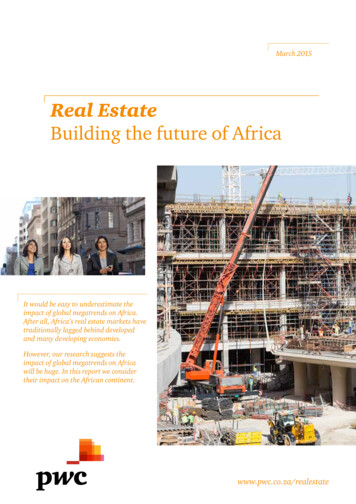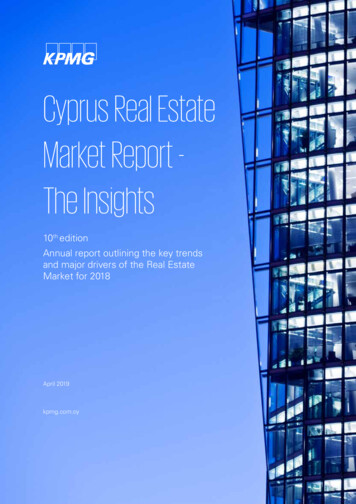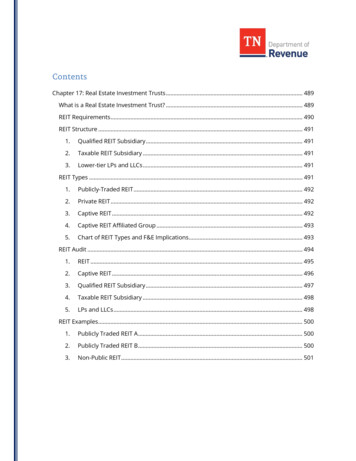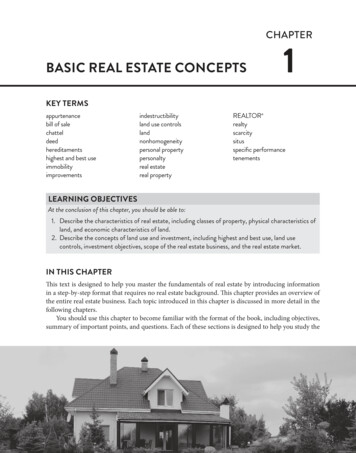
Transcription
March 2015Real EstateBuilding the future of AfricaIt would be easy to underestimate theimpact of global megatrends on Africa.After all, Africa’s real estate markets havetraditionally lagged behind developedand many developing economies.However, our research suggests theimpact of global megatrends on Africawill be huge. In this report we considertheir impact on the African continent.www.pwc.co.za/realestate
100Building the future of Africa
ContentsForeword2Section 1Real Estate 2020: Building the future3Section 2Building the future of Africa – Drivers for real estate growth12Section 3Country analysisCountry profiles:NigeriaKenyaGhanaSouth ts and recognition83Contacts84PwC
ForewordGlobal megatrends, such as rapid urbanisation anddemographic changes, will lead to substantial growthin the global real estate industry over the next fiveyears. Opportunities in the industry will surge, aswill assets invested in the sector. These are some ofthe major findings of PwC’s Real Estate 2020:Building the future report. But how will thesemegatrends impact the hugely diverse sub-regionaland national markets on the African continent?2Building the future of AfricaIt would be easy to underestimatethe impact of global megatrendson Africa. After all, Africa’s realestate markets have traditionallylagged behind developed and manydeveloping economies. Levels ofinvestment in real estate in Africaare low by a global standard, whilesignificant challenges exist inexploiting potential opportunities.The report also considers thereal estate market in 10 selectedcountries in sub-Saharan Africa.These country profiles provideinsight into local, regional andglobal influences on the real estatemarkets of individual countries,providing an illustration of impactsof trends being felt at a nationallevel.However, our research suggests theimpact of global megatrends onAfrica will be huge. In this reportwe consider their impact on theAfrican continent. Our objectiveis to provide an assessment ofthe current state of the realestate industry across Africa anddemonstrate how megatrends willdrive growth opportunities in keyAfrican markets.We hope our report will provideinsight into the real estate market inAfrica and help to identify some ofthe opportunities, risks and rewardsencountered by investors in Africanreal estate.Ilse FrenchPwC Africa Real Estate Leader
Section 1Real Estate 2020: Building thefutureDuring March 2014, PwC releasedReal Estate 2020: Building thefuture, a report which highlightsglobal trends and makes certainpredictions about the real estateindustry up to 2020. Some of theseglobal trends are already evidentin the African real estate industry,while others will only start toappear in the future.The six predictions that the RealEstate 2020: Building thefuture report made for 2020 andbeyond are: The global investible realestate universe will expandsubstantially, leading to a hugeexpansion in opportunity,especially in emergingeconomies; Fast-growing cities will presenta wider range of risk and returnopportunities; Technology innovation andsustainability will be key driversfor value; Collaborating with governmentswill become more important; Competition for prime assets willintensify further; and A broad range of risks, includingnew risks, will emerge.PwC3
Global institutional-grade eloping countriesDeveloped countries10.3201220.33.72020Compound annual growth rateSource: PwC analysisThese predictions reflect the impactof global megatrends observed inthe report. Real Estate 2020:Building the future observesthat global megatrends will changethe global real estate landscapeconsiderably in the next fiveyears and beyond, and Africais no exception. The six globalmegatrends highlighted in RealEstate 2020: Building thefuture are: Huge expansion in cities,with mixed results. By 2020,the twenty first century’s greatmigration to the cities will be wellunderway. Cities will be swellingacross the fast-growing countriesin Asia, Africa, the Middle Eastand Latin America. Even thedeveloped Western nations willbe urbanising, albeit at a slowerpace. But not all cities willprosper. While some will becomegreat centres of wealth creationin a multipolar world, others arelikely to fail.4Building the future of Africa Unprecedented shifts inpopulation drive changesin demand for real estate.Demographic shifts willaffect demand for real estatefundamentally. The burgeoningmiddle-class urban populationsin Asia, Africa and South Americawill need far more housing.Meanwhile, the advancedeconomies’ ageing populationswill demand specialist typesof real estate, while theirrequirements for family homeswill moderate. Emerging markets’ growthratchets up competitionfor assets. Real estate is anintegral part of the emergingmarkets’ growth phenomenon.Even as growth moderates inmany emerging markets, the paceof construction activity remainsrapid, increasing investmentopportunities. The rise ofemerging economies is alsoincreasing competition amongreal estate managers and theinvestment community.
‘Sustainability’ transformsdesign of buildings anddevelopments. Citiescontribute an estimated 70%of the world’s energy-relatedgreenhouse gases whileoccupying just 2% of its land.Their locations – often in lowelevation coastal zones – andlarge populations make themparticularly vulnerable to theimpacts of climate change,such as rising sea levels. As theworld rapidly urbanises, so thepressures to make buildings moreeco-efficient are mounting.As stated in Real Estate 2020:Building the future, while mostof these global megatrends arealready becoming evident, there is anatural tendency to underestimatetheir impact. The impact of manyof these megatrends on the Africalandscape will differ from theexpected impact in developedcountries.In this report we look at the impactof these megatrends on some ofthe fastest growing and developingeconomies on the African continent. Technology disrupts realestate economics. Technologyis finally coming to real estate. By2020, technology will have bothaltered the economics of entiresubsectors of the industry, andchanged the way that real estatedevelopers and the investmentcommunity operate. Real estate capital takesfinancial centre stage.Private capital will play acritical role in funding thegrowing and changing need forreal estate and its supportinginfrastructure. Just as assetmanagers, real estate funds andsovereign wealth funds (SWFs)find the assets under theircontrol swell, so governmentswill have an increasing need forcapital to finance urbanisation.Private real estate capital willbecome an important partner ofgovernments.PwC5
The drivers for growth in AfricaFrom our analysis of these megatrends, we have identified eight potentialdrivers of growth in the real estate industry in Africa.1Africa’s young population will drive the demand forreal estate and different types of real estate. AcrossAfrica there will be continued urbanisation, anexpansion of current cities and the rise of new cities.According to the World Bank, Africa’s median age was 19.7 years in 2012,and it is expected to increase to 25.4 years in 2050, making Africa thecontinent with the youngest population. The global megatrend relatingto ageing populations and the consequent increase in the demand forretirement homes is therefore not expected to have a significant impact inAfrica by 2020. Projections suggest that in 2015 the continent will have apopulation of 226 million aged between 15 and 24 years1. This is expectedto double by 2045.2 This young population will drive growth in the demandfor housing. This may include new or emerging residential subsectors, forexample student housing.Population Density(people per km2 ofland area)0-910 - 2425 – 4950 – 7475 – 99100 – 149150 – 299300 Source: World Bank’s World Development Indicators6Building the future of AfricaAfrica is the world’s second-largestand second-most populouscontinent with 30.2 million km2 or20.4% of the total global land area.Mauritius is the most denselypopulated country on the continentwith 639 people per km2, whileNamibia is the least denselypopulated with three people perkm2.3 The figure alongside showsthe diversity of population densityin Africa.
Continued urbanisation will have a major impact by 2020, and beyond. It isestimated that the urban population in Africa will increase to 56% in 2050,making it the most rapidly urbanising region in the world.4 The figure belowshows the estimated urban population of a selection of African cities by2025, compared to 2010:Growth of Africa cities:% increase, 2010 – 2025 forecastCity population, forecasts,20102025Algiers0Dar es IbadanAddis AbabaAccraJohannesburgAl-Qahirah (Cairo)Al-Iskandariyah (Alexandria)El Djazaïr (Algiers)Cape TownDar-el-Beida CasablancaAddis AbabaAbidjanAccraIbadanDakarNairobiDoulaDar es SalaamLagosKinshasaJohannesburg10mLuanda2mCape TownDurban0mSource: United Nations Population Division, World Urbanisation Propectus, the 2014 revisionThe UN expects the fastest-growing urban agglomerations across Africa to bemedium-sized cities and cities with fewer than one million inhabitants.5 Theunprecedented shifts in demographics will affect the demand for real estatefundamentally. In the residential sector, growing urban populations willincrease demand for affordable housing, while a burgeoning middle-classwill drive demand for more mid-range properties. While office, industrial,retail and residential will remain the dominant sectors, affordable housing,agriculture, healthcare, retirement and mixed-use properties will becomesignificant sub-sectors in their own right.PwC7
2Industrialisation will continue across Africa andwill be accompanied by a rapid growth in the retailsector.Indications suggest that industrialisation will be funded by foreign investors,such as China. Intra-African trade and investment will continue to be animportant driver of growth, as high-profile local companies expand intoregional markets. The retail sector will also develop rapidly as growingpopulations and burgeoning middle classes demand greater volumes ofmore varied goods. The need for economic diversification, together withgrowth, will support the expansion of non-resource sectors and investmentopportunities will arise through an increase in demand for real estate fromthese sectors.3The export of natural resources and agriculture willremain key sources of economic growth, but willexpose certain countries to increased risk.Natural resources will remain a major source of economic growth in Africa.New discoveries continue to drive the growth of local activity, although thiscontinued dependency on natural resources will present both opportunitiesand challenges for real estate developers and investors across the continent.As global demand for food grows, revenue from Africa’s agriculturaloutput will increase, while Africa’s significant area of uncultivated arableland will provide opportunities for growth. The risk presented by theeconomic fragility of commodity-exporting countries must be offset by thepotential rewards from investment – either directly in helping to exploitnew commodity discoveries, or indirectly through developments aimedat catering to the increased consumer demand resulting from associatedeconomic growth.4Infrastructure shortages will create opportunitiesfor investment.Growth sectors will continue to create demand for infrastructure investment.Connections to road, rail and public transport are vital for urban success.Doing business in Africa remains a challenge as infrastructure lags wellbehind the rest of the world, but there are distinct regional differences.Recent PwC research suggests that infrastructure spending in sub-SaharanAfrica will exceed US 180* billion per annum by 2025, a growth rate of10% per annum.6 Major infrastructure investment programmes in Nigeriaand South Africa are now being accompanied by significant projects in othercountries like Ghana, Kenya, Mozambique and Tanzania. However, a hugeshortfall in government funding creates opportunities for private investors tosupport this development need through direct investment and public-privatepartnership (PPP) agreements.*Local currencies were converted to US dollar (US ) and are approximate8Building the future of Africa
5The influence of government policy and legislationon the decision to invest will increase, while localpartnerships will become increasingly important.Increased political stability on the continent and increased participationin local partnerships will continue to ease investors’ concerns relating toinvesting across Africa. Collaborating with governments or involving alocal partner in future real estate developments in Africa will become moreimportant to mitigate the risks. Governments and the investment communitywill have to work together to fund and build cities and their infrastructure.6Continued advancement within pension fund,stock exchange and banking regimes will facilitateinvestment, and an increased range of investorswill drive demand for real estate investmentopportunities.Development finance institutions (DFI), sovereign wealth funds (SWF) –government-run investment vehicles that manage state-owned assets – andprivate equity providers continue to enter the market alongside privatecapital and institutional investors, while developers and investors will findraising capital in the markets easier as the local financial apparatus develops.With interest from a range of investor classes and continued high returns,competition for prime real estate and infrastructure assets will increase.7Technology will impact business and buildingpractices as well as consumer behaviour.Online technology is already having a significant impact on the finance andbanking industry across Africa with the rise of mobile banking. However,the full impact of technology on real estate in Africa will only be felt in themedium to long term, as access to technology increases across the continentand the traditional consumer culture in Africa begins to change. Innovativeand low-cost building technologies will also help make housing affordable.PwC9
8Sustainability will become entrenched in buildingdesign and occupier requirements, with Africa’smost ambitious countries changing city design andbuilding practices.We observed that in certain countries where new cities are being built,developers are using eco-friendly technologies to reduce their environmentalimpact. Some of these technologies include solar building integration,climate responsive building strategies, renewable building materials,recycling and reuse, ecological building materials, an integrated planningprocess, low-cost design and the use of innovative design tools, as can beseen in One Airport Square in Ghana. This trend is expected to continue inAfrica, albeit at a slower pace than in the developed world. Konza City inKenya, Eko-Atlantic in Nigeria and Roma Park in Zambia are just a few ofthe entirely new urban villages focusing on the concept of ‘place making’ ina sustainable way. Use of these new technologies will be accelerated by newsustainability legislation in the most progressive African markets.Risks of investing in AfricaOne of the key predictions made for 2020 relates to the emergence of newrisks, together with the rewards attributed to the new risks. Africa has 54very different countries with low connectivity between them, and there is nosingle answer for ‘which countries to invest in’. Some of the additional risksof real estate investment in Africa include: The impact of political instability and changing government policy; Social instability resulting from inequality; A lack of economic diversity, with an overdependence on naturalresources; Complex legal considerations, such as property ownership rights andinvestment restrictions; The volatility of local currencies against the US dollar; and The timeframe of investments and restrictions on possible exit strategies(e.g. limited institutional investors as compared to more developedmarkets).It is important that investors give consideration to these risks when investingin Africa.10Building the future of Africa
Why Africa?Despite these risks, real estateinvestors and developers continueto see the African market as a hugeopportunity.Investment returns from realestate in Africa’s rapidly expandingeconomies significantly exceedthose achievable in almost alldeveloped markets. Forecasts of20% net annual returns7 frominvesting in shopping malls, officeblocks or industrial complexes incountries across Africa continue todraw in new investors.The opportunities across Africa aresignificant and span every sector.In almost all markets, demandfor high-quality retail, office andindustrial space continues tooutstrip supply as internationaland local occupiers respond tonew economic opportunities.Huge shortfalls in residentialproperty across the continent giverise to opportunities for privatedevelopment on a grand scale,while a lack of local funding forinfrastructure projects providesa platform for new privatepartnerships with the public sector.Demographic shifts and changes inconsumer behaviour create demandfor different types of real estate,allowing the entry of more specialistinvestors into the market.Economic growth, improvingpolitical stability and ongoinginvestments in infrastructure areopening previously inaccessiblemarkets, while increasedtransparency and availability oflocal partners is helping to improvethe ease of doing business. Barriersto local market entry may be high,but by entering the market early,investors may be able to reap therewards in the form of high returnsand exploit new opportunities asthey arise.African opportunities can beexploited best by combining thecompetitive advantage of individualcountries into a coordinatedbusiness model. For example, sucha model might combine developedSouth African capital markets withhigh retail growth in less developedcountries.Risk appetite remains an importantconsideration for any investor inAfrica, but for those real estatecompanies that can accept andmanage these risks there aresignificant rewards on offer fromthe right investment.Africa isredefining itselfthrough real estate* Recognition on page 83PwC11
Section 2Building the future of Africa –Drivers for real estate growthMegatrends in Africanreal estateThis section dicusses themegatrends that will drive growthin the real estate industry in Africa.12Building the future of Africa
1Africa’s young population will drive the demand for real estate anddifferent types of real estate. Across Africa there will be continuedurbanisation, an expansion of current cities and the rise of new cities.Africa currently represents 15% ofthe world’s population and 3% ofthe world’s GDP. Africa also has arelatively young population. Thecontinent currently has a populationof 200 million aged between 15 and24 years8 and this is expected todouble by 2045.9 Between 2010 and2020 Africa’s consumer spending isalso expected to double.10 The WorldBank now classifies 27 of the 54countries in Africa as either mid- orhigh-income countries – 12 morethan in 2000. Zambia and Ghanawere upgraded to mid-incomestatus in 2011.Real GDP growth (%)%65432102011201220132014Sub-Saharan Africa20162017WorldSource: Global Economic Outlook: Sub-Saharan Africa regional forecast”, The World Bank11GDP annual growthEstimated population (Millions)It is estimated that the GDP of subSaharan Africa will grow at 4.6% in2015 and 4.9% in 2016. Growth foroil exporting countries is expectedto be above the continental averageat between 5.5% to 5.6% perannum for the same period. Theseprojections reflect the importanceof oil prices to growth in oilexporting countries. A sustainedperiod of the low oil price, as hasbeen experienced from late 2014,may undermine GDP growth andregional real estate markets. Forthose countries in North Africa,individual GDP growth forecastsrange from 3.3% to 5.5% in 2015and 3.5% to 6.0% in 2016.2015250NigeriaUS 521bn200150EgyptUS 271bn100KenyaUS 55bnGhanaUS 48bnSouth AfricaUS 350bn50AlgeriaUS 210bn00.01.02.03.0AngolaUS 124bn4.05.0DRCUS 32bnMozambiqueUS 15bnTanzaniaUS 33bn6.07.08.09.0GDP annual growth estimated for 2017 shown as a % for each countryThe size of the bubbles represents the size of the economy (GDP 2014)Source: World BankAfrica’s urban and rural population trends1 6001 4001 200Millions1 0196619621958019542001950By 2050, Africa will accountfor almost 24% of the world’spopulation. As at 2014, 40% ofAfricans were urbanised. Theworld’s average for the same periodwas 54%; by 2030 this will increaseto 47%, and by 2050 56% will beurbanised.12 This will be the resultof 400 million people in Africamigrating from rural areas to cities.Lagos is expected to be the twelfthlargest city in the world by 2025.13It is predicted that Africa’s share ofthe global workforce will increasefrom 13% in 2010 to 25% by 2050.14The UN predicts that the urbanpopulation in Africa will surpass therural population by 2037.15UrbanSource: United Nations Population Division, World Urbanisation Propects,the 2014 revisionPwC13
A recent study by Standard Bank16indicates that by 2030 the numberof middle-class households acrossthe 11 fastest-growing countriesin Africa17 will have increased to40 million from today’s 15 millionhouseholds. Many of the largestcities in Africa are growing rapidly.Nairobi, Kinshasa and Dar esSalaam, for example, are expectedto see population growth of over70% by 2025. Nigeria alone will add7.6 million middle-class households,followed by Ghana with 1.6 million.Angola and Sudan will add onemillion middle-class householdseach. On a scale of urban populationand GDP growth, Nigeria is farahead of the rest.The middle class is clearly risingAs successful cities attract moreand more people, the cost of primeurban real estate per square metrewill continue to rise. Affordabilitywill fall, leading to greater urbandensity and smaller apartments.Developers will become moreinnovative about how theydesign and build commercial realestate, seeking to use space moreefficiently. Construction techniques,such as prefabricated buildingsand 3D printing, offer potentialfor fast, cheap and eco-friendlydevelopment.Africa’s growing middle class454035Millions30252015105019902000Total middle-class households20142030Total lower middle-class householdsSource: Standard Bank, Understanding Africa’s middle class%1 01.115300200100326.7303.9115.321.01980Upper class204.425.21990Middle class105157.548.82000Lower class46.12010Middle class % of populationSource: PwC analysis, Middle class defined as those earning 4 to 20/dayBuilding the future of Africa3025600014358000
Population changes will not onlyaffect the demand for goods,but Africa’s fast-growing youngpopulation will also drive demandfor a different type of real estate –for example student housing.Age distribution%The change in demographics andincreasing urbanisation createsignificant infrastructure needsand funding requirements. It isestimated that there is a shortfall of17 million housing units in Nigeriaalone, with a funding requirementof US 363 billion.18 The real estatesector contributes 7.78% to theNigerian GDP.19 The significantinvestment shortfall createsopportunities for investors in thelong run.50403045%46%2040%1026%11%8%00-14WorldIn South Africa, for the academicyear beginning January 2015,207 000 university studentsand 400 000 students inFurther Education & Training(FET) institutions will not haveadequate housing.20 Nigeria,Kenya and Ghana also facesignificant shortages in studentaccommodation, leading to someprivate investors targeting thestudent housing market for futuredevelopments.20%15-4445-554%65 AfricaSource: United Nations Population Division, World Population Prospects, the 2010 revisionAccording to the World Bank,Africa’s median age was 19.7 yearsin 2012 as compared with a globalmedian of 29.7 years. Africa’smedian age is expected to increaseto 25.4 years by 2050, and Africawill remain the continent withthe youngest population. Africaneconomies face the challenge ofensuring this young population isemployed in order to promote stablegrowth.PwC15
With young, growing populationsin most countries, the chance for a‘demographic dividend’ looks good.But a growing population can onlydrive growth if enough people areabove the poverty level and areemployed.The Gini index – a measureof income inequality where 0represents complete equality and100 represents perfect inequality –shows there is significant variationin income inequality across Africa.According to World Bank analysis,over the last five years South Africahas had a Gini index score of 65 andNigeria, a score of 43.In Nigeria, Africa’s most populouscountry, 84.5% of the populationlived below the US 2/day povertyline in 2010, up from 83.1% in2004. In Mozambique, only 2.6% ofthe population is considered part ofthe ‘stable middle class’ (per capitaconsumption level of US 4 to 20/day). The situation is already verydifferent in Egypt, where around30% of the population have made itinto the middle class.21Africa’s worrisome youthunemployment is normallyassessed against the continent’sfast economic growth. Theunemployment rate in Africa is 6%,compared to the global averageof 5%.22 The difference may notseem significant, but the issue isthat unemployment in Africa ismainly affecting young people. It isestimated that youth unemploymentis twice that of adults and accountsfor 60% of all unemployment.23 Themajority of African governmentsare intervening to alleviate theyouth unemployment problem. Oneexample is the National StudentFinancial Aid Scheme of SouthAfrica.Demographic shifts willaffect demand for real estatefundamentally. According to PwC’sreport Africa Business Agenda2014, 67% of respondents to thesurvey indicated that urbanisation,closely followed by demographicshifts, will impact their businesssignificantly in the next five years.Megatrend impacting society and ion5%22%2nd14%3rdSource: Africa Agenda 2014, regional responses to PwC CEO survey16Building the future of Africa19%Demographicshifts21%23%1st63%23%
Shifting demographic trends arelikely to create a huge need fornew and different real estate by2020 and beyond. The burgeoningmiddle-class urban populations inAfrica will need far more housing.Residential real estate will becomemore specialised, with local andcultural differences influencinghow this evolves. For example,young professionals may favoursmaller city apartments, whileyoung families may live in gatedcommunity developments outsidethe city centres. In terms offinancing these new developments,residential property is an areaof anticipated growth for listedproperty funds. Currently,residential holdings make up only2.5% of listed property funds, ascompared to 15% in developedmarkets and 25% in otherdeveloping markets.24 As marketsdevelop, funds will begin to increasetheir residential holdings. Therise of mixed-use developments inAfrica should not be underestimatedas people seek to reduce traveltimes by living closer to centres ofemployment, recreation and retail.Satellite citiesPopulation increases in urbancentres will also lead to an increasein the number of satellite cities,albeit at a slower rate to that indeveloped markets where majorcities have already felt the effects ofrapid urbanisation. The emergenceof satellite cities, defined as peoplemoving to rural environments as aresult of the ever-increasing densityof the main cities, is likely to impactonly the largest cities in Africa by2020.Ghana’s Hope City and Kenya’sKonza City are examples of thistype of significant ultra-modernsatellite city development. Bothinclude a mix of both residentialand commercial premises.Developers are also pursuing nearcity developments. Eko-Atlantic,Nigeria, is a major near-citydevelopment expected to changeNigeria’s real estate landscape.Research indicates that high-speedrailways make satellite cities moreattractive while relieving pressureon main cities. By reducing traveltime, high-speed railways pushsatellite cities closer to main cities.Concerns have been raised bycommentators regarding thefinancing, integration and economicsustainability of some satellitecities. However, announcements ofplanned developments suggest thiswill continue to be a trend in Africa.Low-cost housingIncreasing urban populations willincrease demand for residentialproperty across the continent.In the short term this demandwill be primarily for low-costhousing through direct or indirectinvestment spearheaded by thepublic sector.Innovative government solutionsto help low-income householdsaccess mortgage finance are alsobeing developed, such as in Nigeria,where 2.5% of wages is contributedto a fund controlled by the FederalMortgage Bank of Nigeria to providemortgages to low-income familiesand to support the developmentof new homes. In South Africa,the Gauteng Partnership Fund(GPF) is mandated by the GautengDepartment of Human Settlementto accelerate the provision ofhuman settlements. The GPF aimsto assist housing developers withequity-type loans, which enhancesthe bankability of projects toenable senior lenders to finance onfavourable terms. According to thelatest annual report, for the period2012/13, the GPF helped to attractUS 210 million in private-sectorfunding into the affordable housingsector, leading to the delivery of22 000 houses between the GPF’sinception in 2002 and 2013.25Health sectorIncreasing urban populations will
drivers of growth in the real estate industry in Africa. 1 Africa's young population will drive the demand for real estate and different types of real estate. Across Africa there will be continued urbanisation, an expansion of current cities and the rise of new cities. According to the World Bank, Africa's median age was 19.7 years in 2012,











